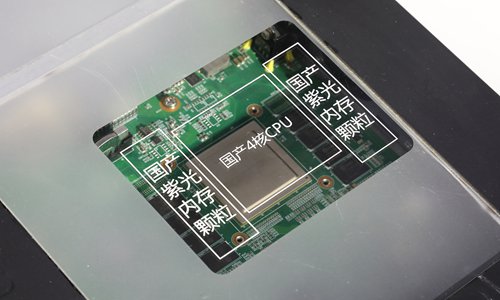HOME >> BUSINESS
YMTC starts mass producing China’s first 64-layer 3D NAND chips
By Li Qiaoyi Source:Global Times Published: 2019/9/2 19:58:40
YMTC starts mass producing China’s first 64-layer NAND chips

A view of the 32-layer 3D NAND flash chip developed by YMTC Photo: IC
Yangtze Memory Technologies Co (YMTC), an affiliate of Chinese semiconductor conglomerate Tsinghua Unigroup, announced on Monday that it has begun mass production of China's first homegrown 64-layer 3D NAND flash memory chips, in a move to push the nation closer to the club of major chipmaking heavyweights.
The chip is the first to be designed and mass produced based on the company's in-house Xtacking architecture. It has a 256Gbit die density, the world's highest for 64- and 72-layer NAND chips, the company said in a statement sent to the Global Times.
The 64-layer chip was showcased at the 2019 Smart China Expo held in Southwest China's Chongqing Municipality in late August. It was then expected to be mass produced at the end of the year, according to media reports.
Hailing the mass production as the mark of its success in carving out a road to innovation in high-end chip design and manufacturing, YMTC said it plans to launch 64-layer 3D NAND solid-state drives and universal flash storage to appeal to manufacturers of data centers, corporate servers, personal computers and mobile devices.
Along with the arrival of 5G, artificial intelligence and the super-sizing of data centers, the demand for flash memory will continue rising, Cheng Weihua, co-chief technology officer of YMTC, was quoted as saying in the statement.
Cheng believes the chip's mass production will inject new vitality into the global memory market.
The move is arguably a breakthrough for the company, which was established in July 2016 to ramp up the nation's chip production capacity, market watchers said.
Compared with 32 layers, 64 layers pose more technological challenges, and the successful mass production indicates that YMTC's indigenous technology research and development team has achieved a level that might potentially pit it against global industry heavyweights, Taipei-based market intelligence provider TrendForce said in response to the Global Times on Monday.
The industry has moved to producing 96 layers of 3D NAND, meaning a gap of about 12 to 18 months in technological terms, according to TrendForce.
Factoring in the company's current production capacity, the chip won't have a substantial impact on the market until the second half of 2020, the market intelligence provider estimated.
In another sign of the nation's march toward high-end chipmaking, the government of Shenzhen, South China's Guangdong Province, on Monday signed an agreement with Huawei - which has been investing heavily in its chip push with its Kunpeng server chips, among other chip portfolios - to forge a Kunpeng industry demonstration area and make joint efforts to build a national industry and manufacturing innovation center.
Semiconductor shares led Monday's stock rally in the Chinese mainland. The sector was up nearly 4 percent, outperforming the key Shanghai Composite Index, which closed up 1.31 percent at 2,924.11 points.
Newspaper headline: YMTC starts mass producing China’s first 64-layer NAND chips
Posted in: INDUSTRIES,COMPANIES